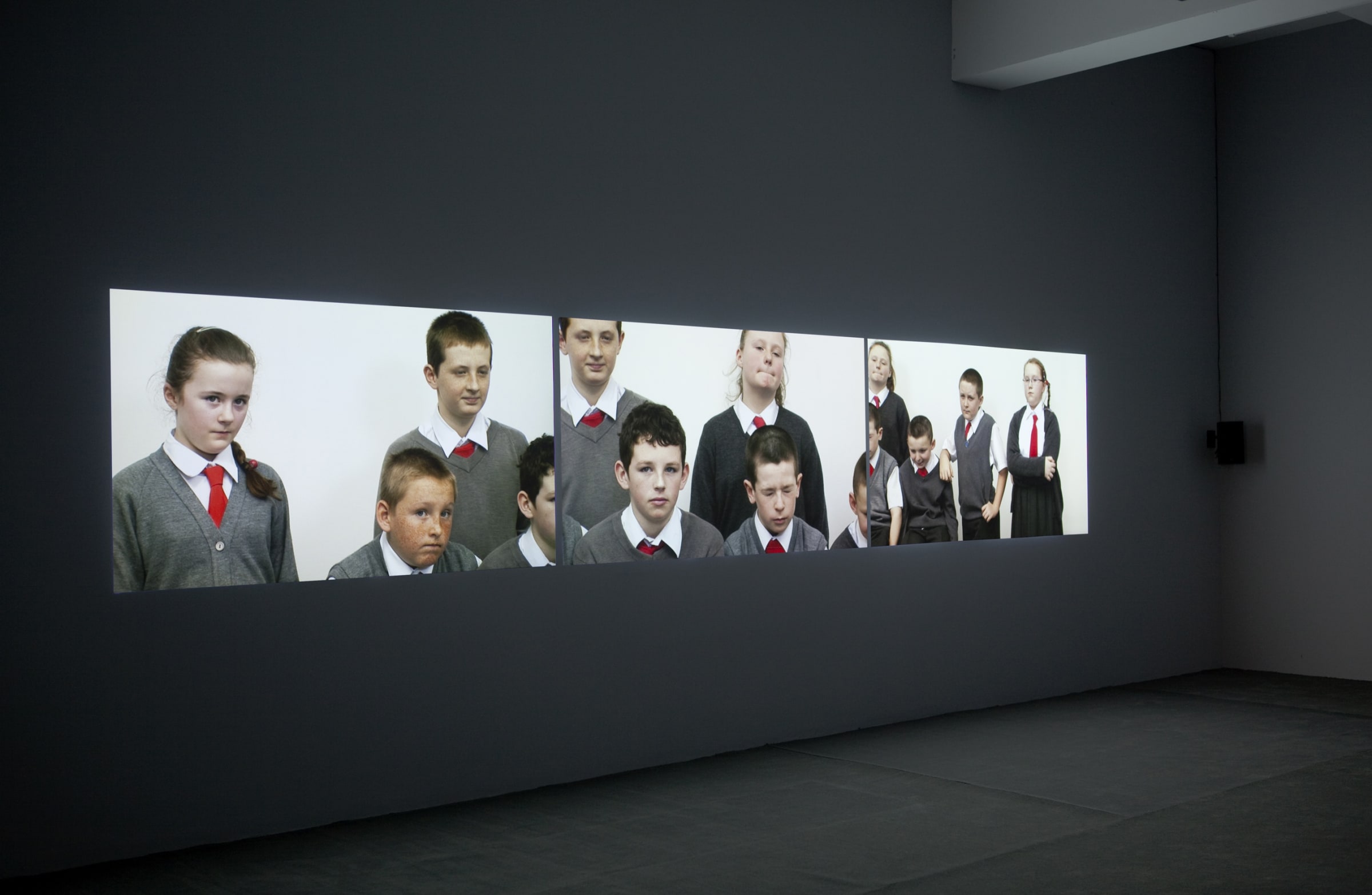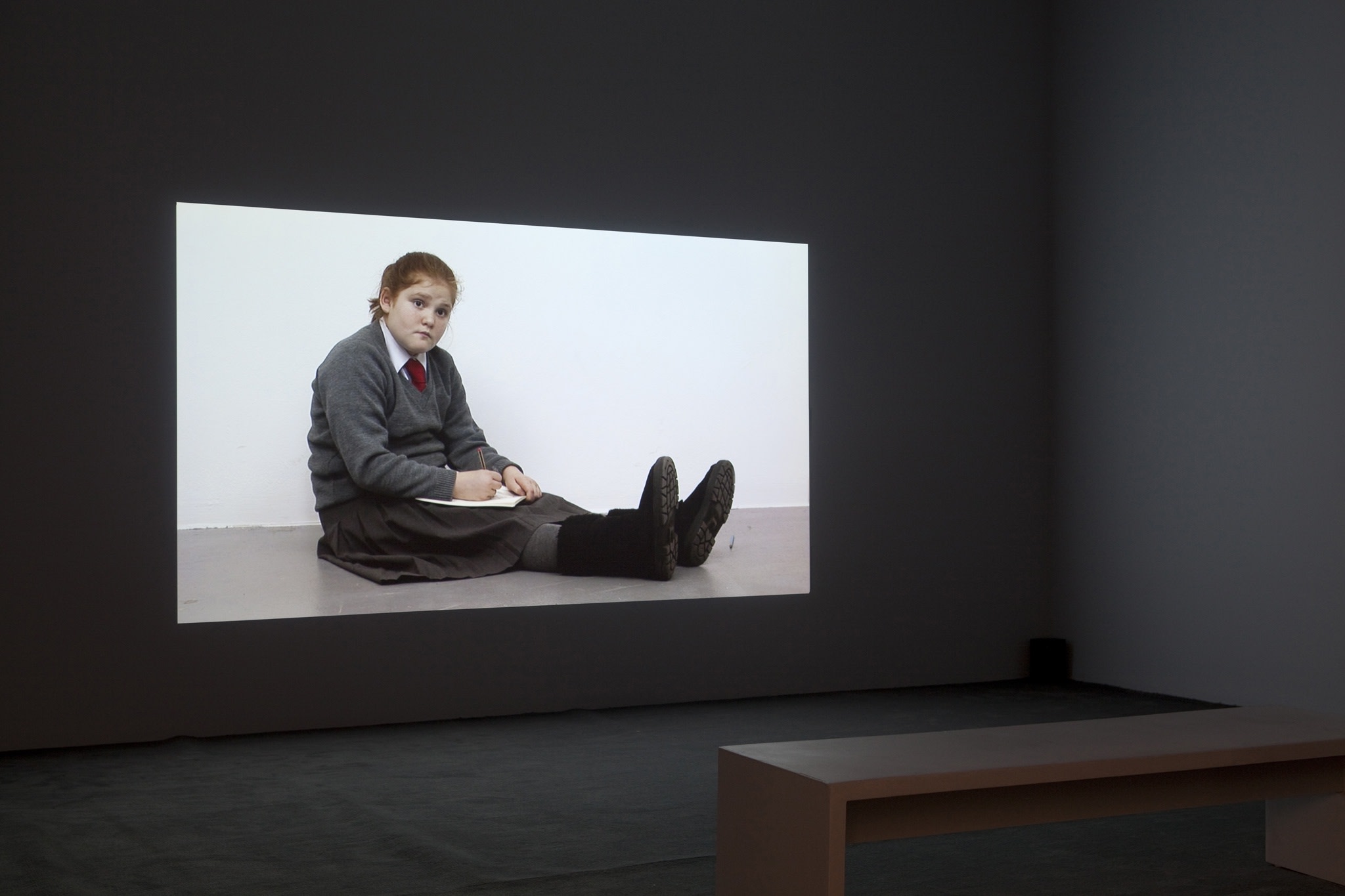Overview
Marian Goodman Gallery is delighted to announce an exhibition of new work by Rineke Dijkstra. On view will be three new video installations as well as related portraits. In the North Gallery the three-channel projection I See A Woman Crying (Weeping Woman), 2009-2010 and single channel Ruth Drawing Picasso, 2009-2010 will be presented. In the South Gallery, The Krazyhouse, Liverpool UK (Megan, Simon, Nicky, Philip, Dee), 2009-2010 will be on view. This new work continues the artist’s relationship with the city of Liverpool, where her celebrated early video work The Buzz Club, Liverpool, UK /Mysteryworld, Zaandam, NL (1996/97) was first created and where her work was recently on view in The Fifth Floor: Ideas Taking Space at Tate Liverpool.
Rineke Dijkstra: I See a Woman Crying (Weeping Woman), 2009-2010
Ruth Drawing Picasso, 2009-2010
The Krazyhouse, Liverpool UK (Megan, Simon, Nicky, Philip, Dee), 2009-2010
June 29 - August 21, 2010
Opening Reception: Tuesday, June 29, 6-8 pm
Marian Goodman Gallery is delighted to announce an exhibition of new work by Rineke Dijkstra which will open on Tuesday, June 29th and will run through August 21st. On view will be three new video installations as well as related portraits.
In the North Gallery the three-channel projection I See A Woman Crying (Weeping Woman), 2009-2010 and single channel Ruth Drawing Picasso, 2009-2010 will be presented.
In the South Gallery, The Krazyhouse, Liverpool UK (Megan, Simon, Nicky, Philip, Dee), 2009-2010 will be on view. This new work continues the artist’s relationship with the city of Liverpool, where her celebrated early video work The Buzz Club, Liverpool, UK /Mysteryworld, Zaandam, NL (1996/97) was first created and where her work was recently on view in The Fifth Floor: Ideas Taking Space at Tate Liverpool.
Ruth Drawing Picasso is a single projection of a schoolgirl’s quiet observation of Picasso’s painting “Weeping Woman” (1937). Ruth sits on the floor and draws with utmost concentration the work of art in front of her. I See a Woman Crying (The Weeping Woman) consists of three projections side by side in which a panorama of school children respond to a Picasso painting. “They are looking directly at us; we are where the art is, which is of course the case given that we are standing in a gallery. It is a conceptual tautology all the more elegant for not advertising itself… an image which can double as a classical portrait as well as a social document” (Mark Prince, in frieze, 03/17/10).
About this work, Rudi Fuchs writes: “’Weeping Woman’ itself (the famous painting by Picasso from 1937) does not appear in Rineke Dijkstra's new film work. What we do see are nine young teenagers looking at each other and wondering what they see. The film was shot with three cameras, placed on tripods along side each other, facing and equidistant to the casually formed row of youngsters. They did not see the painting itself, but a large reproduction of it that was attached to the tripod of the middle camera. This is why—because they were focusing on a point just below the camera's 'line of sight'—none of the youngsters ever (or, if so, just by chance) looks straight into the lens. As such they become a group unto themselves, and it almost seems as though no camera is present. For once their observations and comments begin, they gradually no longer look only at the painting; they then start responding to each other's remarks. This work is therefore not a documentary group portrait but a reminder of the classic 'conversation piece' in English painting. A key part of the subdued atmosphere and tone in the film relates to the figures being concerned with something among themselves which does not involve complying with a story or scenario. Though the creative process is formal, the youngsters are not directed. Just as in Rineke Dijkstra's photographic works actually, the protagonists are completely free, within the design and organization of the mise en scène—that is to say the very shaping of the work—to find a pose with which they feel at ease. Such quiet informality also comes across to us in this film, of course because that is ultimately guided and formed by the controlled cadence of the film images that we see being projected. … Just as in Picasso’s painting, where multiple ways of seeing converge, things happen simultaneously here…. In the kinetic rhythm of those film images, in the shifting of segments, in the severe lines of movement and their alteration –throughout the entire structure of the film – I detect the distant presence of Picasso. As if the film were an impulsive translation of the painting. That makes the rhyme beautifully complete.” -- Rudi Fuchs, 2010.
For both works, Rineke Dijkstra collaborated with Tate Liverpool on the occasion of the exhibition The Fifth Floor: Ideas Taking Space. For this exhibition, the museum constructed a special studio in the Tate Liverpool galleries for the artist, where the video installation I See a Woman Crying and Ruth Drawing Picasso were created. The works were inspired by school groups’ visits to the museum, and the artist subsequently worked with the school children in the constructed studio.
The 4-channel HD video-installation on view in the South Gallery, “The Krazyhouse, Liverpool, UK (Megan, Simon, Nicky, Philip, Dee)”, 2009-2010 was first inspired by Dijkstra’s visit to a nightclub in Liverpool in 2008 whereupon the artist asked teenagers to come to a studio to film them dancing to their favorite tracks. The studio was constructed on the dance floor of the nightclub The Krazy House in Liverpool where the artist was able to work during the weekdays when the club was closed to the audience. “Each clip from ‘The Krazyhouse, Liverpool, UK’, 2009, shows one of the dancers against a stark white background. The clips which last as long as the songs, follow each other end to end, on the four walls of a purpose-built space…. Entirely undecorated, they make us more aware of their subjects and of how they decorate themselves. The single dancer performing for the camera is a scenario both resistant to generalization and symbolically suggestive of the solipsism of youth. It is an ideal template from which to study the drama between self assertion and self doubt. … The moving image is so transparent that we forget how mediated this experience is; how the way we move our bodies is as much a culturally inherited construction as the way we dress, and how these clips are as much about how the dancers mimic the images they have absorbed from the media as how the format of a figure isolated against a white background is itself a recollection of art and advertising conventions. …. We move as others have moved before us. A Goth head-banger plays air guitar; a techno boy preens himself on his slick moves; a shy soul girl lip syncs lyrics, clutching at her heart. … Dijktra does not miss how the Goth boy ends his histrionic mime by grinning sheepishly at the camera, shy at having just exposed his deepest self to its cool gaze.” (Mark Prince, frieze, 3/17/10).
The focus and strength of Rineke Dijkstra’s oeuvre throughout several bodies of work is capturing what is both uniquely personal and universal about her subjects in their rites of passage from childhood to adolescence: “Before our eyes, and quite unself-consciously, we see subjects constructing themselves – revealing themselves in their very process of self-construction.” (Therese St. Gelais, Parachute).
“Self-conscious is an implicitly contradictory description. It can mean to be positively self aware and also the opposite, to be painfully unsure of oneself. Pivoting between these two poles has always been central to Rineke Dijkstra’s portraiture. Her recurring subject is the bumpy ride from adolescence of late teens, when we first become self conscious in both senses of the term.” (M. Prince, frieze, March 2010)
Rineke Dijkstra was born in Sittard, The Netherlands in 1959. She attended the Gerrit Rietveld Academy, Amsterdam from 1981-1986. She has been honored with the Citibank Photography Prize (in 1998), among others. Her work is currently on view in “Pictures by Women: A History of Modern Photography”, on view through August 31st at The Museum of Modern Art, New York. Recent group exhibitions include “The Fifth Floor: Ideas Taking Space”, Tate Liverpool, England; “Pequeña historia de la fotografía”, “Elles”, Centre Pompidou, Paris France ; Centro Galego de Arte Contemporánea, Santiago de Compostela, Spain in 2009 and “Collection Augustin et Isabel Coppel, Mexico: expected/unexpected”, La maison rouge, Paris, France; “Facebook: Images of People in Photographs from the Collection”, The Frances Lehman Loeb Art Center, Poughkeepsie, NY; “Street & Studio: an urban history of photography”, Tate Modern, London, England in 2008.
“Rineke Dijkstra: I See a Woman Crying”, with works from the Liverpool series, will be on view at Tate Liverpool thru August 30 2010. In 2012, a retrospective exhibition of Rineke Dijkstra is scheduled at The Solomon R. Guggenheim Museum, New York and San Francisco Museum of Modern Art.
Please join us at the opening on Tuesday, June 29th, from 6-8 p.m.
For further information, please contact Leslie Nolen at the gallery at: 212 977 7160.
















